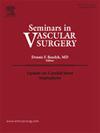Diabetes-Related Extremity Amputation Depression and Distress (DREADD): A Multimethod Study
IF 2.4
3区 医学
Q1 PERIPHERAL VASCULAR DISEASE
引用次数: 0
Abstract
Of the roughly 38 million people diagnosed with type 2 diabetes mellitus in the United States, up to 34% will develop a diabetic foot ulcer at some point, up to 75% of those who develop an ulcer will experience recurrent ulcers, and approximately 18% of patients with a diabetic foot ulcer will undergo lower-limb amputation. The aim of this study was to determine whether depressive symptoms change after a minor, nontraumatic amputation. We conducted a multimethod study consisting of semi-structured interviews (n = 12) and a retrospective cohort (n = 20) of patients with type 2 diabetes mellitus who underwent a nontraumatic, minor amputation of a single toe (partial or total) or partial ray resection. Patient Health Questionnaire-9 (PHQ-9) scores were noted before and after surgery within 30 days of each other. The Wilcoxon matched pairs signed rank test was used to determine differences in the PHQ-9 scores before amputation and after amputation. Of the 20 patients in the retrospective cohort, 90% (18 of 20) had higher PHQ-9 scores within 30 days of amputation. Mean PHQ-9 scores were 3.65 and 12.35 before and after amputation, respectively (a difference of 8.7; P = .0001). Diabetes-related extremity amputation depression and distress is a potentially dangerous complication of diabetes mellitus. Nontraumatic amputations can be a traumatic experience for patients. Surgeons should screen their patients with type 2 diabetes mellitus before and after any (minor or major) nontraumatic amputation and make the appropriate referral, if necessary. Sufficient evidence exists in the literature to warrant the inclusion of psychiatrists and other mental health clinicians in multidisciplinary limb preservation teams.
糖尿病相关截肢抑郁和痛苦(DREADD):一项多方法研究
在美国大约3800万被诊断为2型糖尿病的人中,高达34%的人会在某个时候患上糖尿病足溃疡,高达75%的溃疡患者会复发性溃疡,大约18%的糖尿病足溃疡患者会进行下肢截肢。本研究的目的是确定轻度非创伤性截肢后抑郁症状是否会改变。我们进行了一项多方法研究,包括半结构化访谈(n = 12)和回顾性队列(n = 20),这些2型糖尿病患者接受了单趾(部分或全部)的非创伤性小截肢或部分射线切除术。患者健康问卷-9 (PHQ-9)评分分别于手术前后30天内记录。采用Wilcoxon配对对符号秩检验测定截肢前后PHQ-9评分的差异。在回顾性队列中的20例患者中,90%(20例中的18例)在截肢后30天内PHQ-9评分较高。截肢前后平均PHQ-9评分分别为3.65分和12.35分(差异8.7分;P = 。)。糖尿病相关性截肢、抑郁和窘迫是糖尿病的一种潜在危险并发症。非创伤性截肢对患者来说可能是一种创伤性经历。外科医生应在非创伤性截肢手术前后对2型糖尿病患者进行筛查,并在必要时进行适当的转诊。文献中有足够的证据证明精神科医生和其他心理健康临床医生应被纳入多学科肢体保存小组。
本文章由计算机程序翻译,如有差异,请以英文原文为准。
求助全文
约1分钟内获得全文
求助全文
来源期刊
CiteScore
3.50
自引率
4.00%
发文量
54
审稿时长
50 days
期刊介绍:
Each issue of Seminars in Vascular Surgery examines the latest thinking on a particular clinical problem and features new diagnostic and operative techniques. The journal allows practitioners to expand their capabilities and to keep pace with the most rapidly evolving areas of surgery.

 求助内容:
求助内容: 应助结果提醒方式:
应助结果提醒方式:


